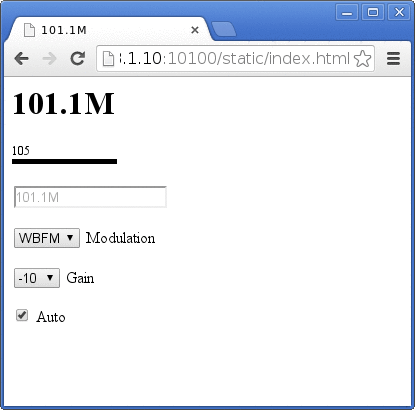An API and web application to interact with a running instance of RTL_FM
This is a Python library built upon the RTL-SDR project and allows you to use the RTL-SDR dongle to tune in arbitrary stations either with a simple web application running on a built-in server, or programmatically with Python or any language using the REST API provided.
I wanted a minimalist remote control for demodulated audio coming from the usb stick and something that could also provide that functionality on the Raspberry PI, or allow for control of multiple dongles through web scripting and VPNs.
- Based on the rtl_fm utility from the RTL-SDR Project https://github.com/steve-m/librtlsdr
- Drop in replacement for rtl_fm
- Live web interface based on React http://facebook.github.io/react/ and Flask http://flask.pocoo.org/
- RESTful API
- Change frequency, demodulation, and gain while running
- Read the RMS signal level
- Interact with rtl_fm with Python
GPLv2
-
Install the RTL-SDR software
-
Install Python dependencies for Flask
sudo pip install flask
-
Compile and link the modified rtm_fm source rtl_fm_python.c
./build.sh
If you have problems let me know. I may not be able to help as I'm not very experienced with building C applications.
- Can crash, probably
- Works best if started with WBFM modulation and sample rates if you're going to be switching around demodulation.
- May get out of sync with the features of rtl_fm due to my time and interest. Pull requests accepted!
Use the script rtl_fm_python_web.py as a replacement for rtl_fm. If you need to change the port or the host, that is available at the end of the file.
Included is a script called start_web.sh that shows an example usage. This script tunes to a broadcast FM station and pipes the audio to Pulse Audio.
By default the application should be running at http://127.0.0.1:10100/
Use the script rtl_fm_python_thread.py with flags identical to the rtl_fm command. When you start the application you will be placed into an interactive shell where you can issue commands.
Returns the current state of the device, for example:
{
"autogain": true,
"freq_i": 102500000,
"freq_s": "102.5M",
"gain": -100,
"mod": "w",
"s_level": 14
}
Modulation modes are denoted as a single letter, w for WBFM, f for FM, a for AM, l for LSB, u for USB, and r for RAW.
Tune the device to a specific integer frequency. For example:
/frequency/101100000
/frequency/144390000
/frequency/162550000
Tune to a human readable string representation of a frequency. For example:
/frequency/human/101.1M
/frequency/human/144390.0K
/frequency/human/0.16255G
Switch the modulation. For example:
/demod/w
/demod/f
/demod/a
/demod/l
/demod/u
/demod/r
Returns the real gain values available. For example:
{
"gains": [
-10,
15,
40,
65,
90,
115,
140,
165,
190,
215,
240,
290,
340,
420
]
}
Set a real gain value for the device. For example:
/gain/-10
/gain/115
/gain/340
This call turns off automatic gain.
Sets the gain given an arbitrary number scale and tries to find a gain that matches. For example:
/gain/human/0
/gain/human/40
This call turns off automatic gain.
Sets the device to be in auto gain mode. The gain may read -100 in the above state call.
get_s_level()
get_frequency()
set_demod_fm()
set_demod_wbfm()
set_demod_am()
set_demod_lsb()
set_demod_usb()
set_demod_raw()
set_frequency(frequency)
set_squelch(level) #untested
get_demod()
set_demod(modulation) #w,f,a,l,u,r
get_gains()
get_gain()
set_gain(value)
get_auto_gain()
set_gain_human(human_value)
set_freq_human(human_frequency)
get_freq_human()
str_to_freq(human_frequency)
freq_to_str(frequency)
printstderr(text)
The rtl-sdr team and community for being awesome.
